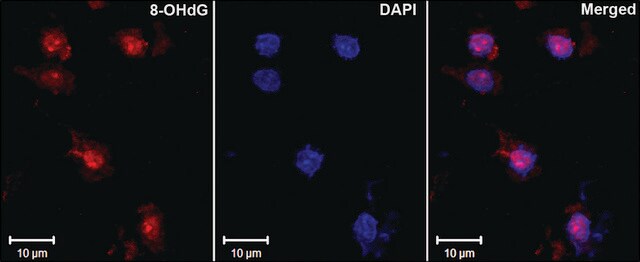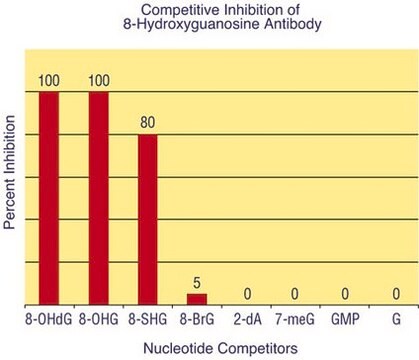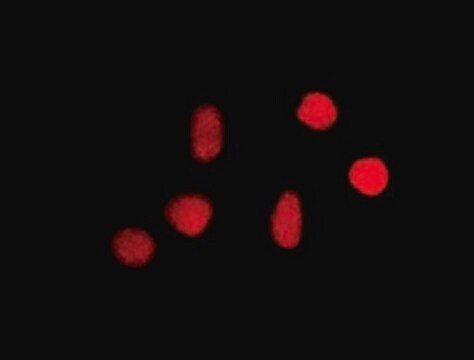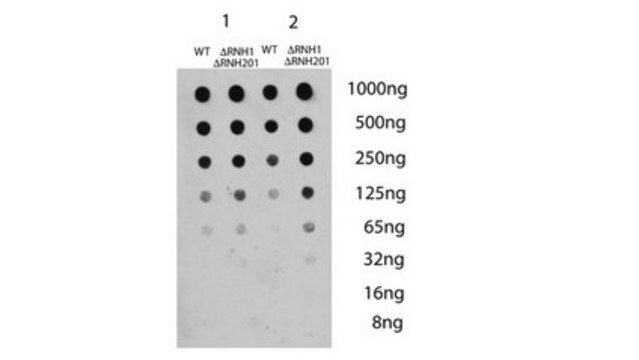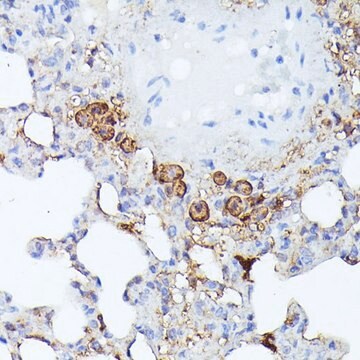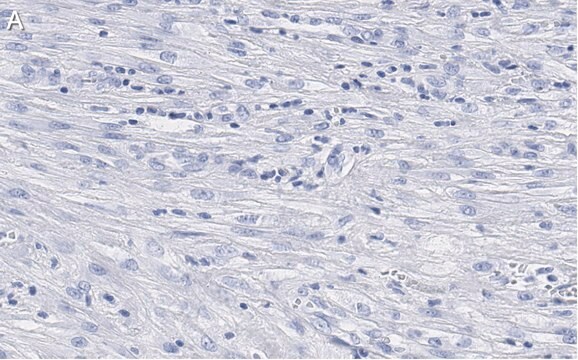MAB3560-C
Anti-8-Oxoguanine, clone 483.15 Antibody (Ascites Free)
clone 483.15, from mouse
Synonym(s):
8-Oxoguanine
About This Item
Recommended Products
biological source
mouse
Quality Level
antibody form
purified immunoglobulin
antibody product type
primary antibodies
clone
483.15, monoclonal
species reactivity
rat, human, monkey, bovine, mouse
species reactivity (predicted by homology)
all
technique(s)
ELISA: suitable
immunocytochemistry: suitable
immunohistochemistry: suitable
isotype
IgMκ
shipped in
dry ice
target post-translational modification
unmodified
Gene Information
human ... OGG1(4968)
General description
Specificity
Immunogen
Application
Immunohistochemistry Analysis: A representative lot detected increased nuclear 8-oxoguanine (8-oxoG) immunoreactivity in paraffin-embedded coronal hippocampus sections from mice induced to express mutated mitochondrial isoform Uracil–DNA glycosylase by fluorescent immunohistochemistry (Lauritzen, K.H., et al. (2011). DNA Repair (Amst). 10(6):639-653).
Immunohistochemistry Analysis: A representative lot detected significantly increased nuclear 8-oxoguanine (8-oxoG) immunoreactivity in ovaries excised from neonatal mice upon exposure to ovotoxic agent 4-vinylcyclohexene diepoxide (VCD), methoxychlor (MXC), or menadione (MEN) in culture by fluorescent immunohistochemistry (Sobinoff, A.P., et al. (2010). Toxicol. Sci. 118(2):653-666).
Immunocytochemistry Analysis: A representative lot detected significantly increased 8-oxoguanine (8-oxoG) immunoreactivity in RINm5F rat insulinoma cells upon IL-1beta or ROS-inducer menadione treatment (Mehmeti, I., et al. (2011). Biochim. Biophys. Acta. 1813(10):1827-1835).
Immunocytochemistry Analysis: A representative lot detected significantly increased nuclear 8-oxoguanine (8-oxoG) immunoreactivity in AC16 human cardiomyocytes upon infection by the hemoflagellate protozoan parasite Trypanosoma cruzi (Ba, X., et al. (2010). J. Biol. Chem. 285(15):11596-11606).
Immunocytochemistry Analysis: Representative lots detected nutrient-deprivation-induced enhancement of nuclear 8-oxoguanine (8-oxoG) immunoreactivity in HeLa and COS-7 cells by fluorescent immunocytochemistry (Conlon, K.A., et al. (2003). DNA Repair (Amst). 2(12):1337-1352; Conlon, K.A., et al. (2000). J. Histotechnol. 23(1):37-44).
ELISA Analysis: Specificity of a representative lot against 8-oxoguanine was confirmed by competitive ELISA. Competition by dGMP, dAMP, dCMP or TMP was only observed when the concentrations were increased to the millimolar range.
Quality
Immunocytochemistry Analysis: A 1:50 dilution of this antibody detected 8-Oxoguanine in HeLa cells.
Linkage
Physical form
Other Notes
Not finding the right product?
Try our Product Selector Tool.
Storage Class Code
12 - Non Combustible Liquids
WGK
WGK 2
Flash Point(F)
Not applicable
Flash Point(C)
Not applicable
Certificates of Analysis (COA)
Search for Certificates of Analysis (COA) by entering the products Lot/Batch Number. Lot and Batch Numbers can be found on a product’s label following the words ‘Lot’ or ‘Batch’.
Already Own This Product?
Find documentation for the products that you have recently purchased in the Document Library.
Our team of scientists has experience in all areas of research including Life Science, Material Science, Chemical Synthesis, Chromatography, Analytical and many others.
Contact Technical Service